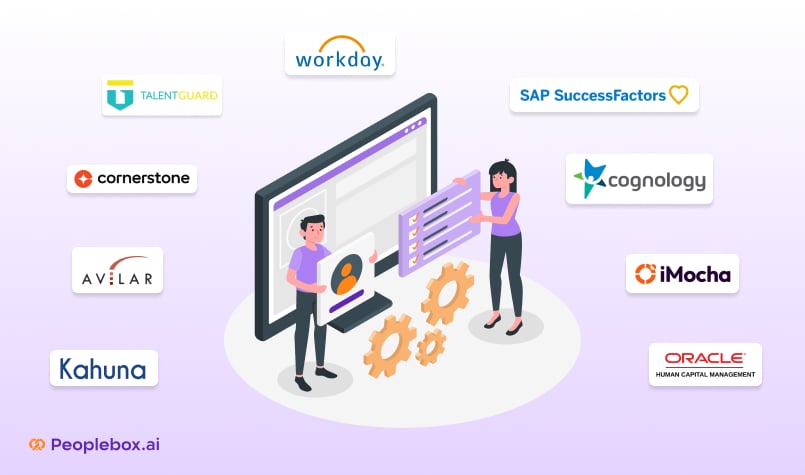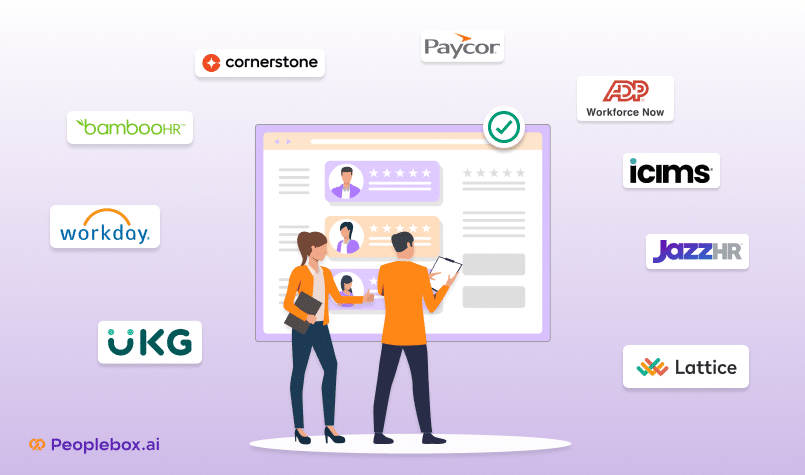Are you an HR professional feeling overwhelmed by the performance management tool and its deployment? Your performance review process is closed and you are worried that this year you have had a bad performance review cycle?
We hear you!
HR professionals often are curious to find why performance reviews didn’t go well as planned. If you are facing challenges after a bad review cycle, identifying the root cause of the problems becomes all the more crucial.
While you deal with this, you are followed by another problem–getting employees and teams to embrace and effectively use new performance review technology.
Overcoming resistance to change and inspiring active engagement with the technology is crucial for fostering a culture of continuous improvement.
In addition, the lack of seamless integration between performance review tools and communication platforms such as Slack and MS Teams hampers the review process.
This becomes an endless loop and HR professionals are trapped in the same old process of creating manual forms and conducting performance reviews. This not only leads to tedious and ineffective reviews but also impacts the overall employee experience. To overcome these obstacles, it’s crucial for HR professionals to explore innovative solutions and embrace technology-driven approaches.
This disruption impacts the overall employee experience and hampers the review process leaving HRs to face these 5 consequential performance review challenges.
Top 5 Performance Review Challenges Faced by HRs in this process
1. Accurate Assessment
One of the significant challenges for HR professionals is addressing the inherent issues associated with subjective performance evaluations. These evaluations are susceptible to biases and unconscious prejudices that can influence the ratings, making it difficult to ensure accuracy and fairness.
Moreover, the lack of standardized evaluation criteria and guidelines further compounds the challenge, as it becomes challenging to establish consistent benchmarks for assessing employee performance.
Strategies to ensure correct evaluation
1. Ask the right questions
Instead of Googling performance review questions and wondering which among those to ask, use the pre-existing templates from platforms like Peoplebox. These templates are specifically designed to facilitate effective evaluation and provide structured guidance for assessing employee performance.
They offer a range of intelligently crafted questions based on advanced algorithms that cover various aspects of job performance, skills, and behaviors. They provide consistency in the evaluation process by offering standardized questions that can be used across different performance reviews.
Read More: 20 Performance Review Questions to Ask for Better Employee Evaluations
2. Determine the appropriate review type
Understand which type of review suits your organization best – whether it’s peer-to-peer, manager-led, self-assessment, or a blend of multiple approaches. Tailoring the review process to your organization’s unique needs enhances the accuracy and relevance of evaluations.
Read More: The Easiest Way for HRs to Create Performance Review Forms in Minutes
3. Communicate strategic context and organizational goals
During performance evaluations, ensure that employees are aware of the strategic context and organizational goals. This helps align individual performance with the broader objectives of the organization, fostering a sense of purpose and direction. By sharing this information, HR professionals empower employees to make informed decisions and prioritize tasks in line with organizational success.
4. Provide training and resources for managers
Offer comprehensive training and resources to managers to equip them with the skills and knowledge needed to conduct fair and objective assessments. This may include workshops on effective evaluation techniques, reducing biases, and providing constructive feedback.
5. Encourage two-way communication and dialogue
Promote open communication during performance reviews, encouraging employees to share their perspectives, concerns, and aspirations. This fosters a comprehensive evaluation process, capturing diverse insights and promoting mutual understanding between reviewers and employees. By actively listening and engaging in dialogue, HR professionals create a collaborative environment that leads to accurate and meaningful evaluations.
2. Lacking – Frequent reviews, performance ratings and recognition
The lack of frequent reviews, performance ratings, and recognition is another challenge that leaves HRs struggling to drive results out of performance reviews. This encompasses several other aspects:
- The limitation of conducting performance reviews only once a year. This hinders the ability to provide timely feedback and course correction. Infrequent reviews limit the opportunity for employees to receive regular guidance and make necessary adjustments to their performance throughout the year.
- The absence of a structured rating system for quantifying and measuring employee performance adds to the challenge. Without a standardized framework, it becomes difficult to objectively evaluate and compare individual performances, potentially leading to subjective assessments.
- Insufficient recognition and appreciation for outstanding performance. Failing to acknowledge and reward exceptional achievements can demotivate employees and hinder their engagement and commitment to continuous improvement.
Strategies to overcome this
To address the challenge of lacking frequent reviews, performance ratings, and recognition, HR professionals can implement the following strategies:
1. Implement a regular performance review cadence
Establish a regular schedule for performance reviews, instead of annual performance review, to ensure timely feedback and course correction. Utilize a suitable platform that simplifies the review process, making it easier to conduct reviews at regular intervals.
For example, you can conduct quarterly performance reviews using a robust user-friendly platform to streamline the administrative tasks associated with performance reviews. A streamlined system will simplify the review process, making it easier for managers and employees to provide and receive feedback, set goals, and track progress.
2. Adopt continuous performance assessment practices
Moving away from the traditional once-a-year review model and embracing continuous performance assessment will not be enough. You will also need to make a shift in approaches and practices. This shift in approach requires a continuous effort to foster a culture of continuous performance assessment.
For example, you can implement regular check-ins between managers and employees to discuss progress, provide feedback, and address any challenges or opportunities for growth. These check-ins can occur on a monthly, quarterly, or project-specific basis, depending on the needs of the organization and the nature of the work.
3. Create a culture of appreciation and celebrate achievements
Foster a culture that values recognition and appreciation for outstanding performance. Establish mechanisms to publicly acknowledge and celebrate achievements, whether through formal awards, team appreciations, or regular appreciation messages. This promotes a positive work environment and motivates employees to excel.
4. Offer opportunities for career growth and support long-term aspirations
Incorporate developmental reviews as part of the performance management process. Provide employees with opportunities to discuss their long-term aspirations, growth goals, and development plans. This demonstrates a commitment to their professional growth and aligns their individual performance with their career objectives.
3. Lengthy and Time-Consuming Process
Conducting comprehensive performance reviews is a lengthy and time-consuming process, involving self-assessment, peer-to-peer review, manager review, and more. Although all this adds time to the process, it is crucial to recognize the value of involving employees in the review process through self-assessment and peer-to-peer feedback. The insights gained contribute to a more accurate evaluation, fostering engagement and commitment to improvement.
Self-assessment helps employees gain the opportunity to reflect on their performance, set goals, and take ownership of their development. Peer-to-peer feedback provides an objective perspective, enhancing fairness and collaboration within the team. Manager reviews are pivotal to performance reviews, we all know.
Strategies to streamline this process
1. Get the right performance management software
Integrate performance management software into the review process, such as leveraging the performance management features offered by Peoplebox. This software streamlines the entire review process and lets you conduct the entire performance review on Slack or MS Teams, making it more efficient and time-effective. You get features like:
- Customization: Customizable review process to tailor the review process according to your organization’s exact requirements, and align with your unique goals and objectives, ensuring a more personalized and effective review experience.
- Automated reminders: Set up specific nudges throughout the review process to prompt employees and managers, ensuring timely completion. Additionally, empower employees to edit and withdraw their reviews easily, fostering a sense of ownership and flexibility.
- Templates: Streamlined convenience by removing manual work and follow-ups. It helps you complete reviews in a matter of hours, not days, with a user-friendly platform that eliminates the need for spreadsheets and simplifies the entire review cycle.
- Integrated systems: One-stop accessibility, on an intuitive interface, for goals, KPIs, performance reviews, and 1:1 meetings, all in real time.
- Reports and insights: Gain real-time insights into the review progress, allowing for efficient execution. You can track review progress by employee, manager, department, and location, without the hassle of creating individual reports.
- Workflow integrations: Seamless integration with existing work tools that eliminate the need for additional platforms. It offers native integrations with popular tools like Slack for running the complete review cycle within the familiar communication platform. With 50+ native integrations, you can keep goals updated in real-time and enhance overall management efficiency.
2. Focus on key performance indicators (KPIs) and essential feedback areas
Streamlining the review process emphasizes the most critical KPIs and essential areas for feedback. This ensures that the evaluation remains focused on the key factors that drive performance and align with organizational objectives.
3. Prioritize follow-up discussions and actionable next steps
Ensure that performance reviews are not standalone events but serve as catalysts for ongoing improvement. Prioritize follow-up discussions to provide clarity on the review outcomes and collaboratively establish actionable next steps with employees.
By discussing specific goals, and areas for development, and providing resources or support, you empower employees to take meaningful action towards their professional growth. This ongoing dialogue and support system requires robust platform support that can help streamline this and contribute to a culture of continuous improvement and development within the organization.
4. Re-engaging employees
According to Forbes, disengaged employees have a 15% lower profitability for a company. While companies with highly engaged employees are 21% more profitable.
Disengagement, burnout, and lack of motivation hinder productivity, satisfaction, and overall performance and about 75% of employees experience burnout.
Disengaged employees exhibit reduced commitment and enthusiasm, leading to decreased productivity. Burnout causes chronic exhaustion and detachment, affecting energy levels and focus. Lack of motivation diminishes employees’ willingness to go above and beyond.
This leaves HR with a big problem to deal with– re-engaging the employees to perform.
Employees are more likely to exhibit passive behaviors, such as reduced productivity and an increased likelihood of quitting. Disengaged employees are more likely to exhibit quiet quitting habits, meaning they may stay with the organization physically but mentally check out from their work responsibilities.
They do not actively participate in meetings, do not volunteer for additional tasks, refuse to work overtime, etc. This leads to a visible decline in productivity levels and high turnover rates, as they lack the motivation, commitment to perform and sense of loyalty to their current role.
Unclear expectations, a lack of growth opportunities, and poor work-life balance, and more other reasons contribute to this high disengagement.
Strategies to re-engage employee and reduce disengagement
1. Create personalized action plans for improvement and growth
Recognize that each employee is unique and may require different approaches to re-engage. Tailor action plans that address their specific needs, goals, and areas of improvement. This personalized approach shows that you value their individual growth and are invested in their success.
2. Identify workload and manage bandwidth
Assess the workload of employees and ensure they have a manageable and balanced workload. A tool helps track what everyone is working on and how much they have on their plate. Help managers prioritize projects and tasks to ensure employees are engaged in meaningful and impactful work while minimizing overwhelming demands. This helps prevent burnout and allows employees to focus on tasks that align with their strengths and interests.
Read More: Manager’s Role in Employee Engagement: Best Practices
3. Engage in conversations about work
Regularly engage in discussions with employees follow-up and address their concerns, clarify expectations, and provide feedback. These discussions should include managers to help create a supportive environment where employees feel heard and understood. Clear communication and guidance contribute to improved engagement and performance.
4. Utilize data-driven insights
Leverage performance management software, such as Peoplebox, to gather data-driven insights on employee engagement levels. Monitor key metrics and use this information to identify trends, areas of improvement, and interventions to enhance engagement. Data-driven insights provide valuable feedback and enable targeted strategies to re-engage employees effectively.
5. Create a positive work culture
Foster a positive work culture that values employee feedback, encourages open communication, and builds trust. Establish channels for employees to share their thoughts, ideas, and concerns. For example, Google has internal channels/ platforms for employees to share their thoughts like Google+. You can create channels on Slack and actively listen to their feedback and take action to address their needs. A culture of appreciation, support, participation, free communication and inclusion promotes a sense of belonging and contributes to higher levels of engagement.
6. Offer opportunities for skill development and challenging assignments
Offer training programs, workshops, and challenging assignments that align with their career aspirations and provide new learning experiences. We have already discussed how investing in employee development shows that you value their potential. This also works as a motivation for them to stay engaged and committed.
5. Employee Retention
According to Globeforce, one of the top challenges for human resource managers today include employee retention, with a staggering 47% of organizations struggling to retain their employees.
Job satisfaction, career growth opportunities, work-life balance, and organizational culture all play a significant role in influencing an employee’s decision to stay or leave. Along with these, the value proposition offered to employees plays a pivotal role in fostering retention.
The current value proposition encompasses the benefits, rewards, compensation packages, and overall employee experience provided by the organization. A compelling value proposition that aligns with employees’ needs and aspirations can enhance their commitment, loyalty, and sense of belonging.
On the other hand, an inadequate or non competitive value proposition may lead to dissatisfaction and disengagement, ultimately increasing the risk of turnover.
Strategies to overcome retention challenges
1. Identify key factors influencing employee retention
Conduct thorough assessments and surveys to understand the factors that impact employee retention within the organization. By identifying these factors, HR managers can tailor retention strategies to address specific needs and concerns.
2. Include retention-focused questions in reviews
Integrate retention-focused discussions into regular performance reviews. This provides an opportunity for open dialogue between employees and managers, allowing them to address any concerns or challenges that may be affecting retention. By actively discussing retention-related topics, HR managers can gain valuable insights and take proactive measures to enhance employee satisfaction and engagement. For example, you can focus on:
- What are your career aspirations within the company, and how can we support your growth and development?
- Are you satisfied with the opportunities for advancement and learning in your current role?
- How would you rate your work-life balance, and is there anything we can do to improve it?
- Do you feel valued and recognized for your contributions to the team and organization?
- What factors contribute to your job satisfaction, and are there any areas where you feel less satisfied? And so on…
3. Offer support to prioritize mental health, work-life balance, and well-being
Employee well-being is a crucial aspect of retention. HR managers should prioritize mental health initiatives, provide resources for work-life balance, and create a supportive work environment. This can include offering:
- Offering flexible work arrangements and creating wellness initiatives, such as fitness challenges, wellness workshops, or access to gym facilities, to promote physical health and well-being.
- Encouraging work-life balance by setting clear expectations around working hours, avoiding excessive overtime, and promoting a healthy integration of work and personal life.
Conclusion
It is crucial for HR professionals to be mindful of the challenges with performance reviews they face and the platform choices they make in order to avoid the negative consequences of bad performance reviews. By addressing the challenges discussed in this article coupled with software that helps in conducting reviews, organizations can ensure effective performance management. By leveraging tools and strategies, HR professionals can enhance their performance management practices and drive positive outcomes.
Recognizing the importance of these challenges, HR professionals must explore innovative solutions that can help them overcome these obstacles. One such solution is Peoplebox, a performance management platform that offers a range of features designed to streamline the review process, promote accurate assessment, and re-engage employees.
By taking proactive steps to address the challenges associated with performance reviews, you can create a culture of continuous improvement. So take a step in that direction and try out Peoplebox!







